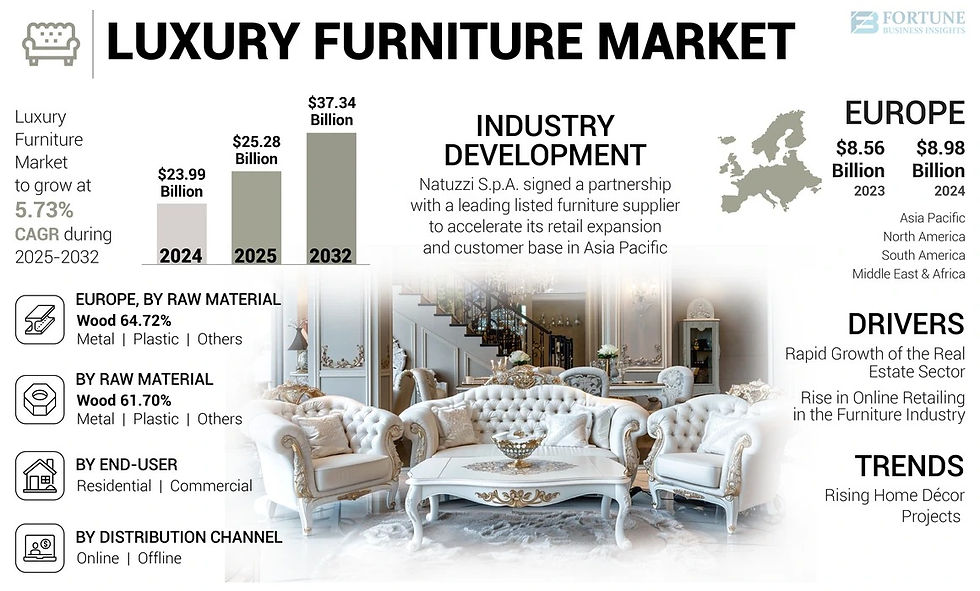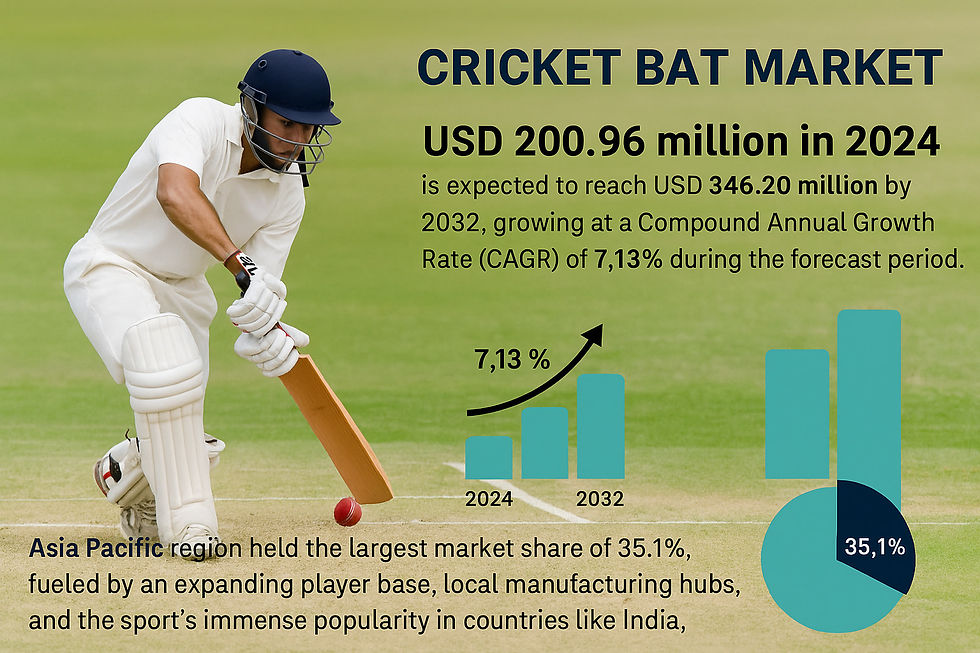Luxury Furniture Market Scope and Industry Growth Outlook 2025–2032
- Reddy S
- Aug 4
- 4 min read
According to Fortune Business Insights, the global luxury furniture market size was valued at USD 23.99 billion in 2024 and is expected to reach USD 25.28 billion in 2025. It is projected to grow significantly, hitting USD 37.34 billion by 2032, at a compound annual growth rate (CAGR) of 5.73% during the forecast period. In 2024, Europe led the luxury furniture market, accounting for a dominant 37.43% market share.
The industry outlook is being positively influenced by growing consumer spending and various other factors such as household debt levels, per-capita income, and consumer expectations. Other aspects, such as ever-increasing disposable income, improvement in sliving standards, growing demand for furniture, and robust popularity of home renovation and decoration projects, will also fuel the market growth.

Request FREE Sample PDF Copy of Luxury Furniture Market Report: https://www.fortunebusinessinsights.com/enquiry/request-sample-pdf/luxury-furniture-market-107326
PROMINENT COMPANIES PROFILED IN THE REPORT
SCAVOLINI S.P.A. (Italy)
Cassina S.p.A (Italy)
Kimball International, Inc. (U.S.)
Brown Jordan International (U.S.)
Herman Miller, Inc. (Knoll Inc) (U.S.)
Vivono (India)
Boca do Lobo (U.K.)
DURESTA (U.K.)
Haworth, Inc. (Italy)
MUEBLES PICO SA (Spain)
Market Trend
The luxury furniture market is experiencing robust growth, driven by rising demand for aesthetically appealing and eco-friendly décor solutions across homes, offices, hotels, and restaurants. Urbanization, growing disposable incomes, and heightened awareness of global design trends—especially in developing economies—are encouraging consumers to invest in premium furniture. Leading players such as Kimball International, Herman Miller (Knoll Inc), DURESTA, and Cassina S.p.A. are responding to evolving consumer preferences, particularly among younger buyers, by innovating in design, materials, and functionality. The rising popularity of multifunctional furniture, coupled with aggressive social media marketing on platforms like Instagram, Facebook, and YouTube, is further expanding market reach and fueling industry expansion.
Segments
Aesthetic Design and High Durability Offered by Wooden Furniture to Support Market Expansion
Based on raw material, the market is divided into wood, metal, plastic, and others. The wood segment is expected to hold a dominant market share, owing to its adaptability and high-quality finishing. Wood is the most popular material due to its high aesthetic value and durability. These features will boost the sales of luxurious wooden furniture.
Rise in Home Décor Projects to Fuel Market Growth
Based on end-user, the market is divided into residential and commercial. The residential segment is predicted to hold a significant market share owing to the large-scale manufacturing of home décor and furnishing products.
Growing Demand for Personalized Shopping Experience to Boost Sales of Offline Distribution Channels
In terms of distribution channel, the market is divided into online and offline. The offline segment is predicted to capture a sizeable industry share as it offers customers a personalized experience and allows them to check a product’s quality through physical inspection.
Report Coverage:
The research report analyzes the industry in detail and highlights several crucial aspects such as prominent companies, competitive landscape, raw materials, end users, and distribution channels. Apart from this, the report also offers insights into the industry trends and underlines many important developments in the market.
Drivers and Restraints:
Rapid Growth of Real Estate Sector to Contribute to the Luxury Furniture Industry Growth
The real estate sector has recently shown substantial expansion due to increased demand for office and residential spaces. The growing construction of residential and commercial buildings will drive the market progress.
The wide availability of counterfeit products might hinder the market development. Counterfeiting also involves placing the logo or trademark of a famous brand on a product, but the product is not manufactured or authorized by that brand.
Regional Insights:
In terms of region, the market is studied across North America, Europe, Asia Pacific, South America, and the Middle East & Africa (MEA). The Europe region is anticipated to capture a sizeable luxury furniture market share during the forecast period as many companies across the region are involved in in-depth research & development. They are also constantly upgrading technologies used in the production of luxury furniture, thereby spurring the product sales across the region.
The North America region is also predicted to hold a major market share as there is a notable presence of reputed luxury furniture manufacturers. Also, the construction of residential and commercial buildings will spur the adoption of luxurious furnishing products.
To get to know more about this market, please visit: https://www.fortunebusinessinsights.com/luxury-furniture-market-107326
Competitive Landscape:
Acquisitions and Partnerships by Leading Companies to Boost Market Growth
Reputed organizations, such as Scavolini S.P.A., Cassina S.p.A., Kimball International, Inc., Brown Jordan International, and many others, are developing a wide range of growth strategies to fortify their presence in the global market. For example, in October 2022, Linly Designs acquired Marge Carson, a luxury furniture brand, which manufactures high-end residential furniture. The deal is expected to enhance operational efficiencies and product offerings.
Key Industry Development:
In December 2022, Kogan.com took over the management of Brosa, one of Australia's largest online retailers of luxury furniture. The deal is anticipated to revive the operations of the popular furniture brand, with the support of the Kogan Group.
In October 2022, Linly Designs acquired the luxury furniture brand Marge Carson, which manufactures high-end residential furniture. The acquisition is expected to enhance operational efficiencies and product offerings.







Comments